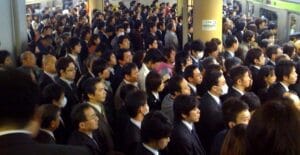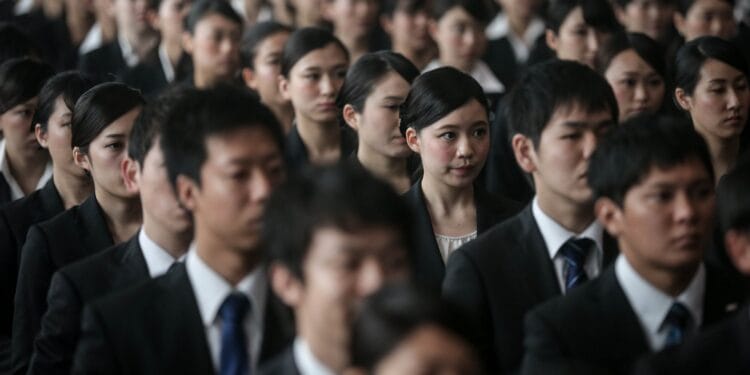No products in the cart.
Why Japanese Salarymen and Workers Wear the Same Uniform: The Streets of Tokyo as a Visual Tradition
Walking through the busy streets of Tokyo, especially during rush hour, you may notice something fascinating: a large number of people in similar attire. Dark suits, white shirts, and black shoes create a sense of uniformity that’s almost mesmerizing. The scene often brings to mind the visual atmosphere of a video game, where characters move in organized patterns, each playing their role in the larger environment. This uniformity is particularly visible among salarymen—Japan’s office workers who are integral to the country’s workforce.
But why do so many Japanese workers dress alike? This blog explores the reasons behind the shared style of the salaryman, looking at how Japanese work culture, tradition, and practical concerns have shaped this practice.
The Salaryman: A Pillar of Japanese Work Culture
To understand why salarymen dress similarly, it’s important to first understand who they are. Salarymen, known as サラリーマン (sararīman) in Japan, are white-collar workers who dedicate themselves to a single company. This lifestyle has long been central to Japanese business culture. Salarymen are viewed as reliable, hardworking, and deeply committed to their company’s success. In return, they often receive job security, regular promotions, and a respected place in society.
For decades, the salaryman has represented stability in postwar Japan, becoming a symbol of economic recovery and growth. Loyalty is key in this relationship between employees and their employers, and this mutual commitment is reflected in the clothing they wear. Dressing in a similar way shows that they are part of a collective effort, working toward a shared goal.
The Uniform: A Sign of Professionalism and Group Harmony
One of the most practical reasons salarymen dress in similar outfits is that it’s part of Japanese business etiquette. Wearing a suit is a symbol of professionalism in Japan. It shows that the person takes their job seriously and is ready to perform their duties. A typical salaryman’s outfit consists of a dark suit, a white shirt, and a simple tie in neutral colors like navy, black, or gray. Companies often have specific dress codes, and employees follow these guidelines as part of their role.
Beyond professionalism, there’s also a cultural reason for this uniformity. In Japan, there is a strong emphasis on group harmony, or 和 (wa). Standing out is often seen as potentially disruptive to this harmony, so dressing similarly ensures everyone feels like part of the team. This reflects the broader value of blending into the group rather than drawing attention to oneself.
For many salarymen, fashion becomes less about individual expression and more about aligning with the company’s expectations and culture. The dark suits you see across Tokyo’s streets are not just a style choice—they’re a reflection of Japan’s deep-seated respect for unity.

Practicality in Everyday Life
Another key reason for the salaryman’s uniform is simple convenience. Deciding what to wear every day can be a time-consuming task, and having a standardized outfit simplifies this process. Many salarymen work long hours, so anything that can streamline their morning routine is a welcome change. A uniform means they don’t have to think much about what they wear, allowing them to focus on their work.
Japan’s weather also plays a role in maintaining consistency in work attire. The summers are hot and humid, while winters can be quite cold. Companies often take part in the Cool Biz initiative, which encourages workers to wear lighter clothing during the hot months to reduce air conditioning use. Even during this period, the variation in clothing remains modest—perhaps short-sleeved shirts instead of long ones—but the overall look is still clean and professional.
Control and Structure in the Workplace
The uniform also contributes to a sense of order and structure within Japanese companies. By encouraging employees to dress similarly, companies can maintain an atmosphere of discipline and control. Uniforms are a way of ensuring everyone stays focused on their tasks and responsibilities rather than spending too much time on personal presentation.
For salarymen, this uniformity can feel both comforting and restrictive. On one hand, it provides a clear framework for how to dress and behave at work. On the other hand, the lack of room for personal expression through clothing can feel limiting. Still, most salarymen accept this as part of their professional role, understanding that the uniform reflects the importance of their contribution to the company.

The Streets of Tokyo: A Harmonized Atmosphere
The uniformity of salarymen contributes to Tokyo’s unique atmosphere, especially during busy hours in places like Shibuya or Shinjuku. The large crowds of workers dressed in similar dark suits give the streets a sense of order and flow. It’s this visual harmony that can remind some of the patterns seen in video games, where characters move in well-organized ways, each playing their specific role in the environment.
This comparison highlights how Japan’s emphasis on predictability and efficiency extends beyond the workplace and into public spaces. Just as non-playable characters (NPCs) in video games move in pre-determined paths, the salarymen in Tokyo’s business districts follow a similar rhythm, moving from office to train station and back again. This synchronized movement contributes to the overall sense of organization that defines Japan’s work culture.
Signs of Change
Although the image of the salaryman remains strong, change is slowly happening. Younger generations are beginning to question traditional expectations, including the rigid dress code. More and more companies are embracing casual work attire, particularly in creative industries and tech companies. Younger workers are also expressing a desire for more balance between work and personal life, leading to gradual shifts in how business is conducted.
Some companies are also experimenting with more relaxed office environments, which includes a more flexible approach to how employees dress. However, these changes are happening gradually, and for now, the sight of men in dark suits remains a common one in Tokyo’s streets.
Conclusion
The uniformity of Japanese salarymen is not just about clothing—it’s about professionalism, group harmony, and respect for tradition. While the streets of Tokyo may seem visually repetitive during rush hour, this sense of uniformity reflects the broader cultural values that drive Japan’s workforce.
Though change is on the horizon, and younger workers are pushing for more flexibility in work culture, the salaryman in his dark suit remains an iconic symbol of Japan’s dedication to hard work, unity, and efficiency. For now, the coordinated appearance of Tokyo’s salarymen continues to contribute to the city’s organized, harmonious atmosphere, making it a unique and fascinating aspect of life in Japan’s urban centers.










